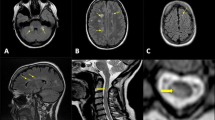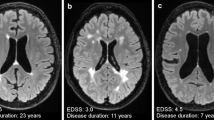Abstract
The application of magnetic resonance imaging (MRI) in multiple sclerosis (MS) has provided powerful insights into the evolution of the disease process over time. MRI has an established role in the diagnosis and has also been used to investigate the natural course of the disease and to monitor treatment effects in clinical trials [1].
Access this chapter
Tax calculation will be finalised at checkout
Purchases are for personal use only
Preview
Unable to display preview. Download preview PDF.
Similar content being viewed by others
References
Miller DH, Grossmann RI, Reingold SC, McFarland HF (1999) The role of magnetic resonance techniques in understanding and managing multiple sclerosis. Brain 121:3–1224
Jacobs L, Kinkel PR, Kinkel WR (1986) Silent brain lesions in patients with isolated idiopathic optic neuritis. A clinical and nuclear magnetic resonance imaging study. Arch Neurol 43:452–455
Ormerod IE et al (1987) The role of NMR imaging in the assessment of multiple sclerosis and isolated neurological lesions. A quantitative study. Brain 110:1579–1616
Ford B, Tampieri D, Francis G (1992) Long-term follow-up of acute partial transverse myelopathy. Neurology 42:250–252
Brex PA et al (1999) Multisequence MRI in clinically isolated syndromes and the early development of MS. Neurology 53:1184–1190
Morrissey SP et al (1993) The significance of brain magnetic resonance imaging abnormalities at presentation with clinically isolated syndromes suggestive of multiple sclerosis. A 5-year follow-up study. Brain 116:135–146
Beck RW et al (1993) The effect of corticosteroids for acute optic neuritis on the subsequent development of multiple sclerosis. The Optic Neuritis Study Group. N Engl J Med 329:1764–1769
Filippi M et al (1994) Quantitative brain MRI lesion load predicts the course of clinically isolated syndromes suggestive of multiple sclerosis. Neurology 44:635–641
O’Riordan JI et al (1998) The prognostic value of brain MRI in clinically isolated syndromes of the CNS. A 10-year follow-up. Brain 121:495–503
Sailer M et al (1999) Quantitative MRI in patients with clinically isolated syndromes suggestive of demyelination. Neurology 52:599–606
Barkhof F et al (1997) Comparison of MRI criteria of first presentation to predict conversion to clinically definite multiple sclerosis. Brain 120:2059–2069
McFarland HF et al (1992) Using gadolinium-enhanced magnetic resonance imaging lesions to monitor disease activity in multiple sclerosis. Ann Neurol 32:758–766
Kappos L et al (1999) Predictive value of gadolinium-enhanced magnetic resonance imaging for relapse rate and changes in disability or impairment in multiple sclerosis: a meta-analysis. Gadolinium MRI Meta-analysis Group. Lancet 353:964–969
Kinkel RP, Simon JH, Baron B (1999) Bimonthly cranial MRI activity following an isolated demyelinating syndrome: potential outcome measures for future multiple sclerosis ‘prevention’ trials. Mult Sci 5:307–312
Jacobs LD, Beck RW, Simon JH et al (2000) Intramuscular interferon beta la-therapy initiated during a first demyelinating event in multiple sclerosis. N Engl J Med 343:898–904
Comi G, Filippi M, Barkhof F et al (2001) Effect of early interferon treatment on conversion to definite multiple sclerosis: a randomised study. Lancet 357:1576–1582
Kurtzke JF (1983) Rating neurologic impairment in multiple sclerosis: an expanded disability status scale (EDSS). Neurology 33:1444–1452
Fazekas F et al (1988) Criteria for an increased specificity of MRI interpretation in elderly subjects with suspected multiple sclerosis. Neurology 38:1822–1825
Poser CM et al (1983) New diagnostic criteria for multiple sclerosis: guidelines for research protocols. Ann Neurol 13:227–231
Filippi M et al (1998) A multi-centre longitudinal study comparing the sensitivity of monthly MRI after standard and triple dose gadolinium-DTPA for monitoring disease activity in multiple sclerosis. Implications for phase II clinical trials. Brain 21:2011–2020
Editor information
Editors and Affiliations
Rights and permissions
Copyright information
© 2004 Springer-Verlag Italia
About this chapter
Cite this chapter
Pozzilli, C. et al. (2004). Serial Magnetic Resonance Imaging in Patients with a First Clinical Episode Suggestive of Multiple Sclerosis: Outline of a Research Protocol. In: Hommes, O.R., Comi, G. (eds) Early Indicators Early Treatments Neuroprotection in Multiple Sclerosis. Topics in Neuroscience. Springer, Milano. https://doi.org/10.1007/978-88-470-2117-4_13
Download citation
DOI: https://doi.org/10.1007/978-88-470-2117-4_13
Publisher Name: Springer, Milano
Print ISBN: 978-88-470-2171-6
Online ISBN: 978-88-470-2117-4
eBook Packages: Springer Book Archive




